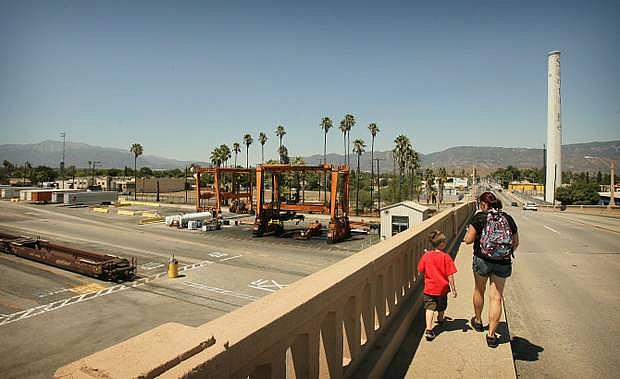HEALTH: Children are more vulnerable to air pollution effects
Children breathe more air per pound of body weight than adults. They also spend more time outside and are more physically active, which further increases their exposure to air pollution.
This report was produced in part with a grant from the Lucile Packard Foundation for Children's Health Journalism Fund, awarded by The California Endowment Health Journalism Fellowships at the USC Annenberg School of Journalism.
Other portions of this story:
AIR POLLUTION: Battle still on for clean air
POLLUTION: Microscopic particles can cause internal havoc
CLEAN AIR: Reducing air pollution extends lives
CLEAN AIR: A promise still elusive for Inland region
TRUCKING: A job opportunity for former dairyman
AIR QUALITY: Warehouse plan closely watched

A women and child walk along the Mt Vernon bridge that goes over the BNSF Railway San Bernardino Yard on Friday, August 23, 2013 in San Bernardino. STAN LIM/STAFF PHOTOGRAPHER
Biologically speaking, “children are not just little adults,” says Ed Avol, a USC preventive medicine professor and member of national science committee that advises the U.S. Environmental Protection Agency on outdoor air health standards.
Because their brains and other organs are still developing, the toxic effects of pollution can cause damage that has the potential to affect them for the rest of their lives.
“It is like if you mix the cement poorly when you are building the base of a building, the building forever will have a bad base,” Avol said.
Children also get a bigger dose of whatever is in the air:
Compared with adults, they breathe more air per pound of body weight.
They also spend more time outside and are more physically active, which further increases their exposure to air pollution.
Their internal air passageways are smaller, which means more lung tissue surface is exposed per volume of air.
The list of known or suspected potential harm to children is long and getting longer. It includes low birth weight, birth defects, autism, asthma and other lung disorders, learning problems and obesity.
This story originally ran in the Press-Enterprise on September 5, 2013. Check out the story there.

